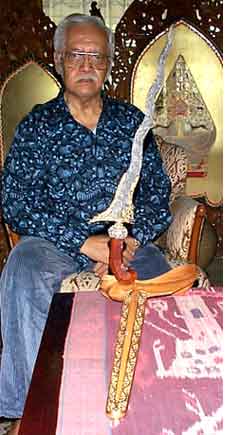|
JAKARTA (indo.com): The widespread tales that the Keris
(or kris), a traditional weapon, possesses magical
powers that allow it to fly or move by itself inside a cupboard
have enthralled many, spurring not only locals but also
foreign tourists to purchase these ornate knives when visiting
Indonesia. Does a keris have really
supernatural power, a life of its own? The answer depends
entirely on individual's own perception.
Keris are found in Java, Sumatra, Bali
and other islands of the archipelago, and have also been
used in the Malay Peninsula, Southern Philippines and Thailand
since as long ago as the 13th century. The most ornate ones
are made in Java, dating back to the kingdoms of Jenggala,
Daha, Kediri, Singasari, Pajajaan, Majapahit, Demak, Pajang,
Mataram. Today the keris continues
to be made as a home industry in Indonesia, especially in
Madura and East Java.
Experts on keris focus on many different
aspects of the weapons in order to fully understand them,
viewing them from different aspects, such as the historical,
cultural, archaeological, anthropological, as well as considering
all the legends, mythology and ethnology.
Haryono Haryo Guritno, 69, is one example. "keris
has an image of technology," he told indo.com recently.
For him, the most fascinating aspect of the keris
is the art of welding the patterns and sectioning.
 Haryono,
a retired naval officer and a mechanical engineering graduate
of the Bandung Institute of Technology (ITB), has devoted
his life to writing a book on the keris based
on scientific research. He also makes them. Haryono,
a retired naval officer and a mechanical engineering graduate
of the Bandung Institute of Technology (ITB), has devoted
his life to writing a book on the keris based
on scientific research. He also makes them.
He shares the belief that the keris has magical
powers because he believes that there are certain cultural
elements that should be maintained, particularly those which
do not contradict religion and certain ethical norms. "True,
a keris is believed to be 'loaded' (with something),
but it is 'loaded' for various scientific reasons, depending
on the fabrication process.
People's views on religion and politics are intermingled
with customs, beliefs, myths, and legends. These views change
in accordance with changes in value systems and the patterns
of cultural beliefs that they adopt. "Therefore, if we believe
that a keris has a supernatural power, we flash back
to 100 years ago," he said.
The making of a keris is preceded by ceremonies,
offerings, and magic formulae to strengthen the belief that
the keris has magical powers. Owners of a keris
who believe in magical power conduct a certain ceremony
to wash or 'bathe' their weapon during the first month of
the Javanese lunar year - with offerings consisting of selected
flowers, rice, fruit, and incense to preserve its supernatural
power.
In terms of its fabrication, a keris is welded from
various different metals that fall into two groups: metal
derived from the earth and metal derived from the atmosphere.
Materials from the atmosphere means meteor and asteroid.
"If the iron is welded or combined with another material
from the atmosphere, then it is considered that there is
a marriage between the cosmos and the world, which the Javanese
call the marriage between bopo angkoso and ibu pertiwi.
Mythologically speaking, a keris made from atmospheric
materials is said to have the power of God," he said.
Welding certain kinds of metals into one blade causes them
to form patterns, known locally as pamor. "Pamor" - or damascene
- is the most striking feature of the kris. Iron gives the
keris its body, and the steel its cutting edge. But
it is the nickel that gives the blade its pamor, according
to Haryono. The pamor is brought out and made visible through
a process of washing the finished blade in a solution of
arsenic and limejuice.
Pamor symbolizes certain hopes, there being around 150 different
kinds of pattern. For example, a pattern of Beras Wutah
- scattered rice grain - is considered lucky, as a man must
be wealthy to scatter rice grains away. A pattern of Udan
Mas - rain of gold - means that it is good for the businessman
as it brings torrents of wealth.
Until today, some people believe keris not only to
be weapons but also family heirlooms and status symbols.
To recognize whether a keris is suitable to be conserved
as an heirloom, an expert will look at it from three aspects:
condition, material and style, Haryono said. Others consider
keris to be works of art. Anybody can order an empu
(a keris maker) to make one, or one can be bought
in Jakarta at antique and craft stores on Jl. Surabaya,
Kemang, Ciputat or in Sarinah Department Store.
As a cultural heirloom, the keris, will remain everlastingly
fascinating even if scientific information on the object
will, someday, overshadow the tales of mysticism. "The higher
the levels of education we have and the more complete the
background information, the more curious we will be," Haryono
Guritno said.
|







